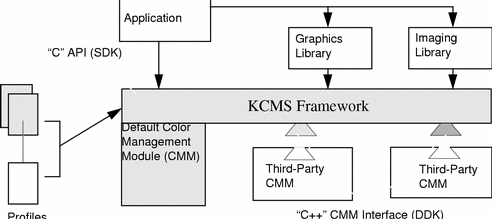In This Chapter
This chapter introduces you to the KCMS framework classes. The chapter assumes your familiarity with the KCMS architecture. See Figure 1-1.
As a brief review, the KCMS architecture consists of components supplied by SunSoft (shown in gray in the figure) and other components (shown in white) that the developer can add. Towards the top of the figure, you see the KCMS "C" application programming interface (API). It consists of a group of functions that allow an application to communicate with the KCMS framework to manipulate profiles in a device-independent manner. The KCMS "C"API is described in detail in the SDK manual KCMS Application Developer's Guide. This manual assumes that you are familiar with the API functions.
The color management module (CMM), shown below the KCMS framework, is the component that ultimately does the color management. The default CMM includes all the classes described in this chapter.
Other CMMs use different techniques for evaluating color data, which can result in differences in quality, profile size, and speed of color manipulations. To add a new third-party CMM to the framework, you can only derive from four of the classes described in this chapter and you can extend one. Collectively, these classes are referred to as the C++ CMM interface in the figure. Although you can only derive from a few classes, you need to understand the inner workings of all the classes to understand what is being inherited in the implementation of the CMM you write.
Figure 1-1 KCMS Architecture

- © 2010, Oracle Corporation and/or its affiliates
